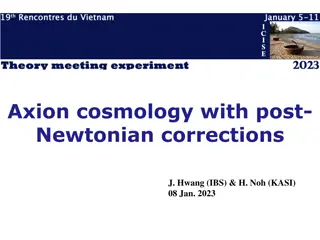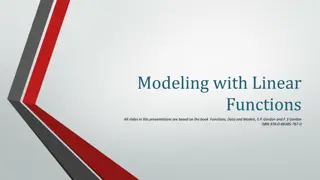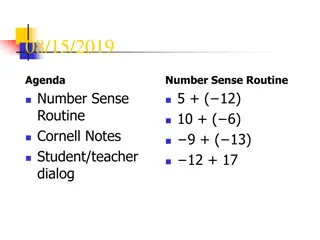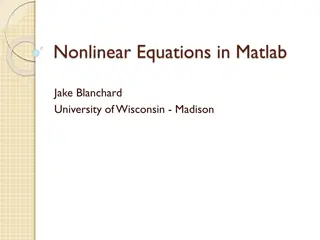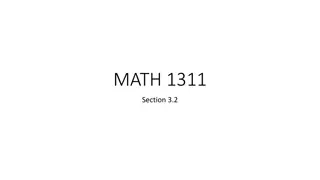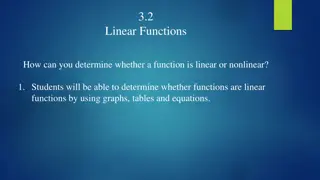Understanding Linear and Nonlinear Functions in Mathematics
Explore the concepts of linear and nonlinear functions in mathematics through identifying linear and nonlinear functions from graphs, understanding the characteristics of linear functions, and identifying linear functions from tables. Learn about the constant rate of change, slope, and how to determine if a function is linear or nonlinear based on different criteria.
Download Presentation

Please find below an Image/Link to download the presentation.
The content on the website is provided AS IS for your information and personal use only. It may not be sold, licensed, or shared on other websites without obtaining consent from the author. Download presentation by click this link. If you encounter any issues during the download, it is possible that the publisher has removed the file from their server.
E N D
Presentation Transcript
May 4, 2020 Good morning and welcome to math class! You need paper and pencil. If you printed out the 6.3 Practice worksheet, please have it ready to go.
Section 6.3: Understanding Linear and Nonlinear Functions Objectives: Students will be able to Identify Linear Functions Identify Nonlinear Functions from graphs Describe and Sketch Functions
Recall that a function is a relation where each x-value is paired with exactly one y-value. Which of these graphs show functions? How do you know? HINT: What test can we use? Graph A Graph B Graph C
Which of these graphs show functions? How do you know? HINT: What test can we use? FUNCTION FUNCTION NOT A FUNCTION
What is a linear function? It is a function whose graph produces a non-vertical LINE. Since the function is a line, the graph (and table of values) will have a CONSTANT RATE OF CHANGE This constant rate of change is known as SLOPE.
No matter which two points we use to find the slope, we get the same answer. The slope is constant throughout the function. ???? ???= ? ? = -1 ???? ?? ?????? = ???? ???= ? ? = -1 ???? ?? ?????? = ???? ???= ? ? = -1 ???? ?? ?????? =
Identifying Linear Functions from a Table Rate of Change from first point to last point ???? ?? ? ???? =36 12 24 8= 3 = 9 1 Important Note: In a linear function, the rate of change between any two points is always the same!
Identifying Linear Functions from a Table Notice here that values in the rows above do not show a consistent pattern, but the ratios of ? ???? ?? ? -6. This is still a linear function! ? ???? ?? ? are all equal to
Step 1: fill in the x- and y- differences. Step 2: List the three rates of change. Are they all the same? Step 3: Tell if the function is linear and why.
Notice the y-change is in the numerator of each fraction. ???? ???
If you printed out the 6.3 worksheet, take it out now and look at the second page). We are going to do problems from page 269. A few reminders: When submitting homework, do it through Google Classroom. Don t forget your entire Q4 grade is based on successful completion of your homework. Make sure you are arriving to class on time and staying for the entire class.
Notice the y-change is in the numerator of the fraction. ???? ???
5 2 = 5 2 ????? ?? ? ???? 10 4 = 5 2 5 2 = 5 2 Because all the slopes for the function are 5 the function has a constant rate of change. 2, The table represents a linear function.
Step 1: Write in the x-changes and the y- changes above and below the table.
+ 2 + 2 + 2 + 2 - 2 -4 -8 -10 Step 2: List the four rates of change on your paper. Step 3: Tell if the function is linear or nonlinear and explain how you know.
+ 2 + 2 + 2 + 2 - 2 -4 -8 -10 10 2 = -5 4 2 = -2 2 2 = -1 8 2 = -4 Because the rates of change are NOT CONSTANT, the function is NONLINEAR
Homework is due by Tuesday at 11:59 pm Part 1: page 269 #1-2 and page 276 #1-4 copy tables, show rates of change on the worksheet Part 2: 6.1 ws Homework #1-8 - follow all directions. There are several tasks that need to be done. If your assignment is not completely done according to the directions given, it will be returned to you to complete. Submit both parts through Google Classroom.
Section 6.3: Understanding Linear and Nonlinear Functions Objectives: Students will be able to Identify Linear Functions Identify Nonlinear Functions from graphs Describe and Sketch Functions
Warm-up: Do these graphs show functions? Write down how you know.
Both these graphs are functions because they pass the vertical line test (any vertical line intersects the graph only one time). Why do you think only Graph A shows a linear function?
Hint: look at the word linear. What do you see? A linear function is one where all points on the graph lie on one line, like they do in Graph A.
Review from last lesson: Determining linear functions from their tables Tell if this function is linear OR nonlinear. The table shows the increase in size of a hot air balloon as it is filled up with air. Tell whether the relation between the volume of air, v liters, and the time to fill the balloon, t minutes, is a linear function. Step 1: Copy the table. Fill in the x- and y- changes.
Warm-up: Tell if this function is linear OR nonlinear. Check your results: Step 2: Use the x- and y-changes to write three fractions.
Warm-up: Tell if this function is linear OR nonlinear. Step 2: Use the x- and y-changes to write three fractions. The fractions are: 20 1, 20 1, and 40 2. Step 3: Does this function show a constant change?
Tell if this function is linear OR nonlinear. 20 1, 20 1, and 40 The fractions are: 2. . Step 3: Does this function show a constant change? Since all fractions reduce to 20, there is a constant rate of change. Step 4: Is this a linear function?
A linear function shows a constant rate of change. When all fractions reduce to the same number, this is a constant rate of change and is a linear function. A nonlinear function shows varying rates of change. When all fractions ARE NOT equal, this function has a varying rate of change and is NOT a linear function. Our function is a linear function because it shows a constant rate of change.
The line connecting (0, 0) and (3, 9) has a different slope than the line connecting (3, 9) and (6, 36). Therefore, the rate of change in the graph is not constant.
Because the rate of change is not constant, it is not a linear function. d) Is this graph discrete or continuous? Solution The graph is continuous. On the graph, we can see the points are connected. We could find the area of a square with side 1.5 cm.
e) Write the independent variable. Solution The independent variable is the side length of the square. Write the dependent variable. Solution The dependent variable is the area of the square.
f) Give the least possible input value and its corresponding output value. Remember: Input = x. Output = y. Solution The least possible input value is 0. Its corresponding output value is 0. A side length of zero would produce an area of zero.
NOTE: This question has three parts. (1) THINK: How can we tell if this graph is a function? HINT: What test can we use? (2) THINK: How can we tell if this graph is linear? HINT: What word do you see in the word linear ?
This graph is a function, as it passes the vertical line test. This graph is linear, as it is a line. Rise = (8 3) = 5 (3) Find the rate of change. HINT: The rate of change is the same as the slope of the line. Run = (6 0) = 6 ???? ???= 5 6 ???? ?? ? ???? =
???? ???= 5 6 ???? ?? ? ???? = Write the equation of the line in y = mx + b form. What is the y-intercept? From the graph, the y-intercept is 3. The equation of the line is y = 5 6x + 3
Since the graph is a curve, the function is not linear. What does the least possible input appear to be? What is its corresponding output?
What does the least possible input appear to be? Hint: What is the smallest x-value on the graph? Another way to say this could be: On the left, where does our graph start?
The smallest x-value on the graph is -3. This is the lowest input value. What is the corresponding y-value?
What does the least possible input appear to be? What is its corresponding output? There is a point at (-3, -3). -3 is the lowest x-value and the lowest y-value.
Summary: STUDY THESE PROPERTIES OF GRAPHS! Every graph can be described in three different ways. A graph can be a relation OR a function. A graph can be linear or nonlinear. A graph can be increasing, decreasing, or neither.
Every graph can be described in three different ways. A graph can be a relation OR a function. A graph can be linear or nonlinear. A graph can be increasing, decreasing, or neither. EXAMPLE: describe this graph.
Every graph can be described in three different ways. A graph can be a relation OR a function. THINK: does it pass the vertical line test? A graph can be linear or nonlinear. THINK: is it a straight line? A graph can be increasing or decreasing. THINK: does it go up or down? Write the three answers on your paper.
This graph is: A FUNCTION passes the vertical line test NONLINEAR it is not a straight line INCREASING the graph goes up from left to right
Summarize: Write a sentence to answer each question. 1. How do we decide whether a graph is a function? 2. How do we know whether a function is linear a. on a graph? b. on a table? 3. What determines whether the relationship between the two variables of a function is increasing or decreasing?
Check/correct your answers. IMPORTANT CONCEPTS HERE! 1. How do we decide whether a graph is a function? If any vertical line crosses the graph only once, it is a function. (It passes the vertical line test.) 2. How do we know whether a function is linear a. on a graph? It makes a straight line. b. on a table? It shows a constant rate of change. 3. What determines whether the relationship between the two variables of a function is increasing or decreasing? As you move from left to right, if the graph goes up, it is increasing. If it goes down, it is decreasing.
Your assignment is due by Sunday night, May 10. Please submit through Google Classroom. 1. Book page 276 #5-10; follow the directions 2. Worksheet 6.3 Linear Functions Extra Practice #1-10.














